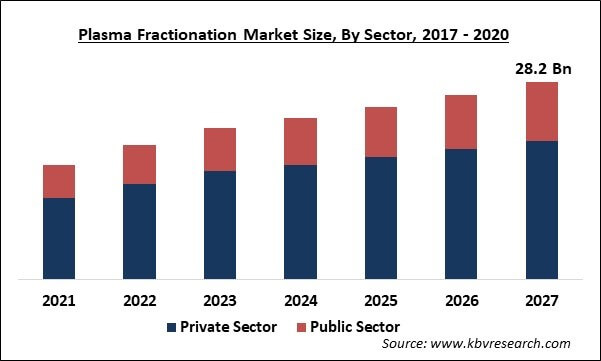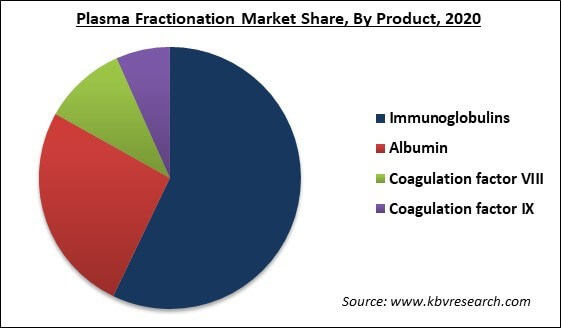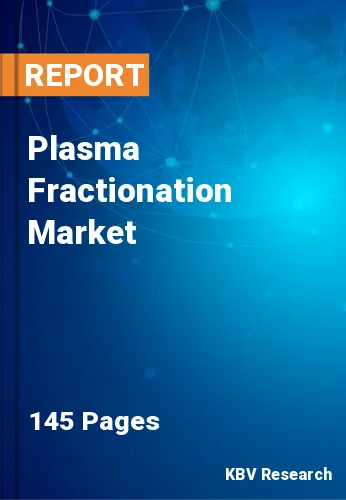The Global Plasma Fractionation Market size is expected to reach $28.2 billion by 2027, rising at a market growth of 9.6% CAGR during the forecast period. Plasma refers to a blood component, obtained from blood by plasmapheresis, and utilized for several therapeutic and medical Products. Human plasma is considered as a source of different proteins. Though, only some of these proteins are beneficial for creating therapeutic plasma products.
The separation process, purification, and extraction of these proteins from the plasma are known as the Plasma fractionation. The proteins obtained from the plasma are majorly classified into major group viz. immunoglobulins, clotting factors, and albumins. Immunoglobulins help in treating various autoimmune diseases and enhance the immune response. Clotting factors are helpful in treating various kinds of blood diseases like hemophilia. Lastly, the albumins are helpful during low albumin levels or fluid loss.

The plasma fractionation process is majorly dependent on various aspects like solubility of the products, and their physical & chemical conditions like ionic strengths, pH levels, and temperature, etc. the extracted plasma items, also called as Fresh Frozen Plasma (FFP) which are then subjected to several physical and mechanical treatments for virus inactivation like Chromatography centrifugation, detergent/solvent treatment, Nanofiltration, heat treatment, sterile filtration and ultrafiltration with an aim to attain homogeneity of plasma extracted from various donors and cut down the risks of viral transmissions.
The outbreak of the COVID-19 crisis has influenced each sector across the world. For example, when WHO declared the COVID-19 as global pandemic, nations around the world imposed strict lockdown restrictions to implement social distancing norms as a method to reduce the spread. This results in disruption, restrictions, challenges, and changes in every segment of every industry. Likewise, the plasma fractionation market has also faced some severe impacts by the pandemic. For example, the COVID-19 crisis has resulted in a reduction in the number of blood donations and plasma collections, which restricted the growth of the global plasma fractionation market as it results in the disruption in raw material supply.
Based on Product, the market is segmented into Immunoglobulins, Albumin, Coagulation factor VIII and Coagulation factor IX. Immunoglobulin procured the maximum revenue share of the plasma fractionation market and would exhibit a promising growth rate during the forecast period. The growth of this segment is due to the varied usage of immunoglobulin in several disorders like primary and secondary immune deficiencies, autoimmune diseases, and inflammatory diseases.

Based on Sector, the market is segmented into Private Sector and Public Sector. Based on the sector, the private sector obtained the maximum revenue share of the overall plasma fractionation market in 2020. This is owing to the numerous private players operating in the plasma fractionation market which gather and fractionate a big amount of plasma into derivatives like albumin, immunoglobulin, and others. Therefore, this is likely to push the growth of the overall plasma fractionation market.
| Report Attribute | Details |
|---|---|
| Market size value in 2020 | USD 17.5 Billion |
| Market size forecast in 2027 | USD 28.2 Billion |
| Base Year | 2020 |
| Historical Period | 2017 to 2019 |
| Forecast Period | 2021 to 2027 |
| Revenue Growth Rate | CAGR of 9.6% from 2021 to 2027 |
| Number of Pages | 145 |
| Number of Tables | 260 |
| Report coverage | Market Trends, Revenue Estimation and Forecast, Segmentation Analysis, Regional and Country Breakdown, Companies Strategic Developments, Company Profiling |
| Segments covered | Product, Sector, Region |
| Country scope | US, Canada, Mexico, Germany, UK, France, Russia, Spain, Italy, China, Japan, India, South Korea, Singapore, Malaysia, Brazil, Argentina, UAE, Saudi Arabia, South Africa, Nigeria |
| Growth Drivers |
|
| Restraints |
|
Based on Regions, the market is segmented into North America, Europe, Asia Pacific, and Latin America, Middle East & Africa. Asia-Pacific displays attractive opportunities for leading players operating in the plasma fractionation market. This is due to the existence of governmental bodies that control and manage plasma collection, fractionation, and sales are the primary aspects that are fueling the growth of the global plasma fractionation market. Moreover, increasing cases of medical conditions like high fever with thrombocytopenia syndrome (SFTS), hemophilia, and primary & secondary immune deficiencies also propel the development of the market.
Free Valuable Insights: Global Plasma Fractionation Market size to reach USD 28.2 Billion by 2027
The market research report covers the analysis of key stake holders of the market. Key companies profiled in the report include Emergent BioSolutions, Inc., CSL Limited, Grifols S.A., Octapharma AG, Takeda Pharmaceutical Company Limited, Kedrion S.p.A, LFB S.A, Biotest AG (Tiancheng International Investment Limited), Sanquin Blood Supply Foundation, and Bio Products Laboratory Limited.
By Product
By Sector
By Geography
The plasma fractionation market size is projected to reach USD 28.2 billion by 2027.
Growing rates of bleeding diseases are driving the market in coming years, however, the advent of recombinant alternatives have limited the growth of the market.
Emergent BioSolutions, Inc., CSL Limited, Grifols S.A., Octapharma AG, Takeda Pharmaceutical Company Limited, Kedrion S.p.A, LFB S.A, Biotest AG (Tiancheng International Investment Limited), Sanquin Blood Supply Foundation, and Bio Products Laboratory Limited.
The expected CAGR of the plasma fractionation market is 9.6% from 2021 to 2027.
The Immunoglobulins market dominated the Global Plasma Fractionation Market by Product in 2020, growing at a CAGR of 9.4 % during the forecast period.
In North America, the US procured the maximum share of the plasma fractional market in 2020.
Our team of dedicated experts can provide you with attractive expansion opportunities for your business.

